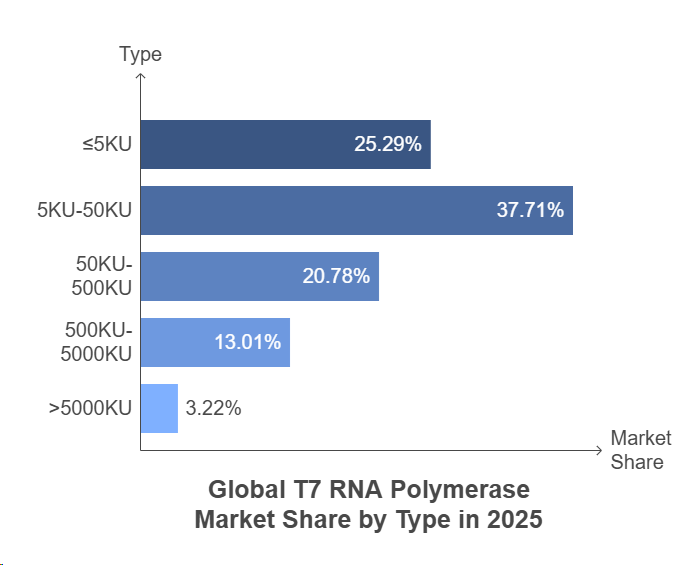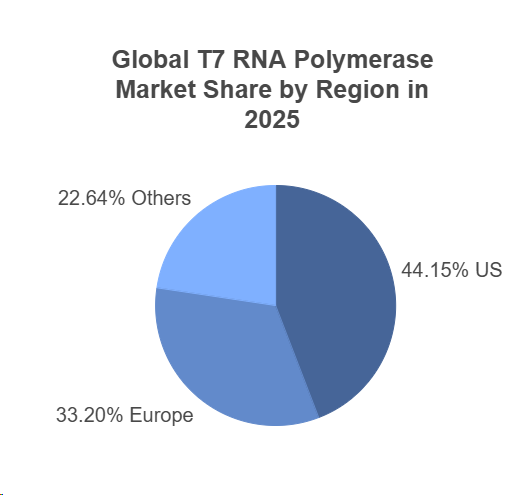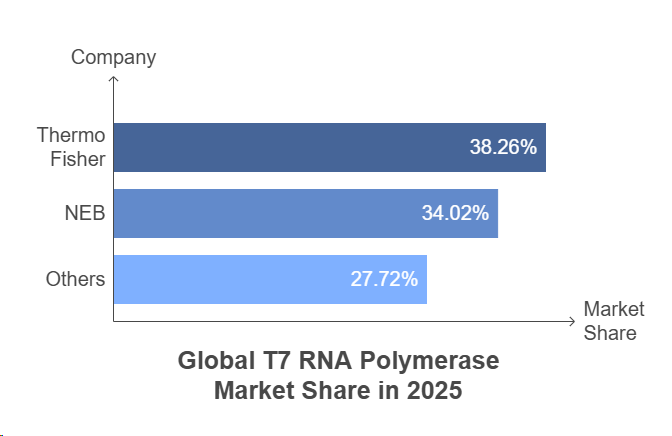1 T7 RNA Polymerase Market Size and Product Definition
T7 RNA polymerase is a DNA-dependent RNA polymerase derived from T7 phage and has highly specific 5’→3′ end RNA polymerase activity. T7 RNA polymerase has high specificity for the T7 promoter and can synthesize a large amount of RNA using the downstream sequence of the T7 promoter as a template.
The global T7 RNA polymerase market is projected to experience steady growth over the next decade, beginning at $60.13 million in 2025 and estimated to reach $146.04 million by 2035. The compound annual growth rate (CAGR) during the forecast period is approximately 8.2%.
Figure Global T7 RNA Polymerase Market Size from 2020-2035

2 T7 RNA Polymerase Market Dynamics
Table Drivers
Drivers | Description |
Advances in Molecular Biology Technology | T7 RNA polymerase is an important enzyme that can synthesize RNA molecules in vitro and is widely used in the fields of molecular biology and genetic engineering. T7 RNA polymerase can selectively synthesize RNA molecules corresponding to DNA templates, with the advantages of high efficiency, specificity and speed. In the fields of RNA chips, RNA interference, RNA structural transcriptomics and other fields, T7 RNA polymerase is widely used in the synthesis and amplification of RNA. In addition, the study of T7 RNA polymerase also provides an important tool for the study of RNA structure and function. The continuous advancement of molecular biology technologies such as NASBA technology, TMA technology, PCR technology, CRISPR-Cas9 technology has driven the market growth of T7 RNA polymerase. NASBA is a novel technique for in vitro isothermal amplification of RNA with specific nucleotide sequence mediated by a pair of primers. The reaction was performed at 42° C and amplified the RNA template about 109-fold within 2 hours. NASBA is a novel technique for in vitro isothermal amplification of RNA with specific nucleotide sequence mediated by a pair of primers. The reaction was performed at 42 ° C, and the RNA template was amplified about 109-fold within 2 h. The NASBA principle is to extract viral RNA and add AMV reverse transcriptase, RNase H, T7RNA polymerase and primers for amplification. The whole reaction is divided into acyclic phase and cyclic phase: in the acyclic phase, primer I and template RNA are annealed under the action of AMV reverse transcriptase to synthesize cDNA to form RNA: DNA heterozygote, then RNaseH degrades RNA, primer II and cDNA are annealed to synthesize a second complementary DNA strand under the action of reverse transcriptase. Double-stranded DNA can be transcribed by its promoter sequence under the action of T7RNA polymerase, and the RNA can be reversed into DNA under the action of reverse transcriptase, enter the circulating phase, and perform large amplification of the template. The principle of TMA technology is basically the same as NASBA, but the difference is that TMA uses MMLV reverse transcriptase and T7 RNA polymerase. MMLV reverse transcriptase has both reverse transcriptase activity and RNase H activity. The reaction was performed at 41.5C, and the RNA template was amplified about 109-fold within 1h. |
Table Industry Limitations
Industry Limitations | Descriptions |
High R&D cost | T7 RNA polymerase is a technology-intensive industry, and the development and commercialization of T7 RNA usually requires several stages, including the use of bioengineering technology to build high-yield strains, optimization of media and production conditions, and improvement of enzyme stability. Each stage requires a significant investment of time and resources. In particular, the barriers to industrial scale-up production are much higher than laboratory-level expression, and it is necessary to ensure that the original activity and purity of the enzyme are not lost in the process of industrial preparation. Developing and commercializing T7 RNA polymerase products is difficult and requires significant R&D investments. As a result, the high costs associated with the production, purification and scale-up of enzymes pose a challenge to market players, especially small companies. |
T7 RNA polymerase may produce many by-products in the process of RNA synthesis | Although T7 RNA polymerase is widely used in RNA synthesis in vitro and protein expression in vivo (bacterial high expression system), in addition to the advantages of high transcriptional efficiency and high elongation ability, it also has some shortcomings as a tool for RNA synthesis in vitro. T7 RNA polymerase may produce many by-products in the process of RNA synthesis, including oligonucleotides produced during transcription initiation, interrupted RNA products caused by termination signals, and 3 ‘end elongation products caused by RNA-dependent RNA polymerase activity. Therefore, there is an urgent need to optimize and improve T7 RNA polymerase so that it can not only maintain efficient transcription, but also reduce the problem of RNA product heterogeneity. |
3 Global T7 RNA Polymerase Market Share by Types
T7 RNA polymerase is an important biological molecule, which is responsible for synthesizing RNA molecules in organisms. In scientific measurement, the activity of T7 RNA polymerase is usually expressed in units (Unit, referred to as U).
T7 RNA Polymerase product types can be divided into ≤5KU, 5KU-50KU, 50KU-500KU, 500KU-5000KU, and >5000KU according to packaging specifications. 5KU refers to the unit specification of 5000U.
In the global T7 RNA polymerase market for the year 2025, the 5KU-50KU category holds the largest market share, accounting for 37.71% of the entire market. This significant portion indicates a strong preference or demand for T7 RNA polymerase within this size range, possibly due to its suitability for a broad spectrum of applications or its high efficiency in performance.
Following the 5KU-50KU category, the ≤5KU category takes the second-largest share at 25.29%, suggesting that smaller packaging specifications also have a substantial market presence. The 50KU-500KU category represents 20.78% of the market share, indicating a moderate demand for T7 RNA polymerase within this size range. The 500KU-5000KU category has a smaller share at 13.01%, and the largest packaging size, >5000KU, has the smallest share at 3.22%. This distribution reflects a market concentration on smaller and mid-range sizes of T7 RNA polymerase, with a tapering interest as the size exceeds 5000KU.
Overall, the market share distribution indicates that while there is a variety of packaging specifications for T7 RNA polymerase available, the demand is not evenly spread across all sizes. Smaller and mid-range packaging specifications are more prevalent in the market, which could influence manufacturers to focus on these segments for production and innovation.
Figure Global T7 RNA Polymerase Market Share by Types in 2025

4 Global T7 RNA Polymerase Market Share by Applications
In the global T7 RNA polymerase market for the year 2025, biopharmaceutical companies dominate the largest market share with 60.01%. This significant portion indicates that T7 RNA polymerase is widely utilized within the biopharmaceutical industry, likely due to its pivotal role in the development and production of RNA-based therapies and vaccines.
Following the biopharmaceutical sector, academic and research institutes hold a substantial market share of 27.86%, highlighting the crucial role of T7 RNA polymerase in research and academic studies. This can be attributed to the enzyme’s importance in scientific research, particularly in the fields of molecular biology and genetics. Contract research organizations account for a smaller segment at 12.13%, indicating a specialized but notable demand for T7 RNA polymerase in contract research settings, which could involve the development of new applications or the customization of RNA polymerase for specific projects.
Figure Global T7 RNA Polymerase Market Share by Applications in 2025

5 Global T7 RNA Polymerase Market Share by Regions
In the global T7 RNA polymerase market for the year 2025, the United States (US) holds the largest share at 44.15%, indicating a significant presence and influence in the T7 RNA polymerase market. This suggests that the US is a key player in the industry, likely due to its robust research and development infrastructure, as well as a strong demand for T7 RNA polymerase in various applications.
Europe follows closely with a considerable market share of 33.20%, reflecting its importance in the global T7 RNA polymerase industry. This significant portion indicates a strong regional demand and a mature market for T7 RNA polymerase products. The “Other” region accounts for 22.64% of the market share, highlighting the global reach and the diverse geographical distribution of the T7 RNA polymerase market. This distribution emphasizes the widespread nature of the industry and the varying levels of market penetration across different regions.
Overall, the market share distribution indicates that the US and Europe are leading in the T7 RNA polymerase market, with a significant presence in other regions as well.
Figure Global T7 RNA Polymerase Market Share by Applications in 2025

6 Global T7 RNA Polymerase Market Share by Major Players
In the global T7 RNA polymerase market for the year 2025, Thermo Fisher holds the largest share with 38.26%, indicating a significant dominant position in the T7 RNA polymerase market. This suggests that Thermo Fisher is a leading supplier in the industry, likely due to its extensive product range, robust research and development capabilities, and strong market influence.
NEB follows closely with a substantial market share of 34.02%, reflecting its strong position in the T7 RNA polymerase sector. The ‘Others’ category, which includes all other companies not individually specified, accounts for 27.72% of the market share. This distribution highlights the competitive nature of the market, with a few major players holding a considerable portion of the market, while a variety of other companies contribute to the remaining share.
Overall, the market share distribution highlights the concentration of the T7 RNA polymerase market among a few major companies, with Thermo Fisher and NEB at the forefront. This insight is crucial for stakeholders to understand the competitive landscape and to strategize their positioning within the industry.
Figure Global T7 RNA Polymerase Market Share by Major Players in 2025






